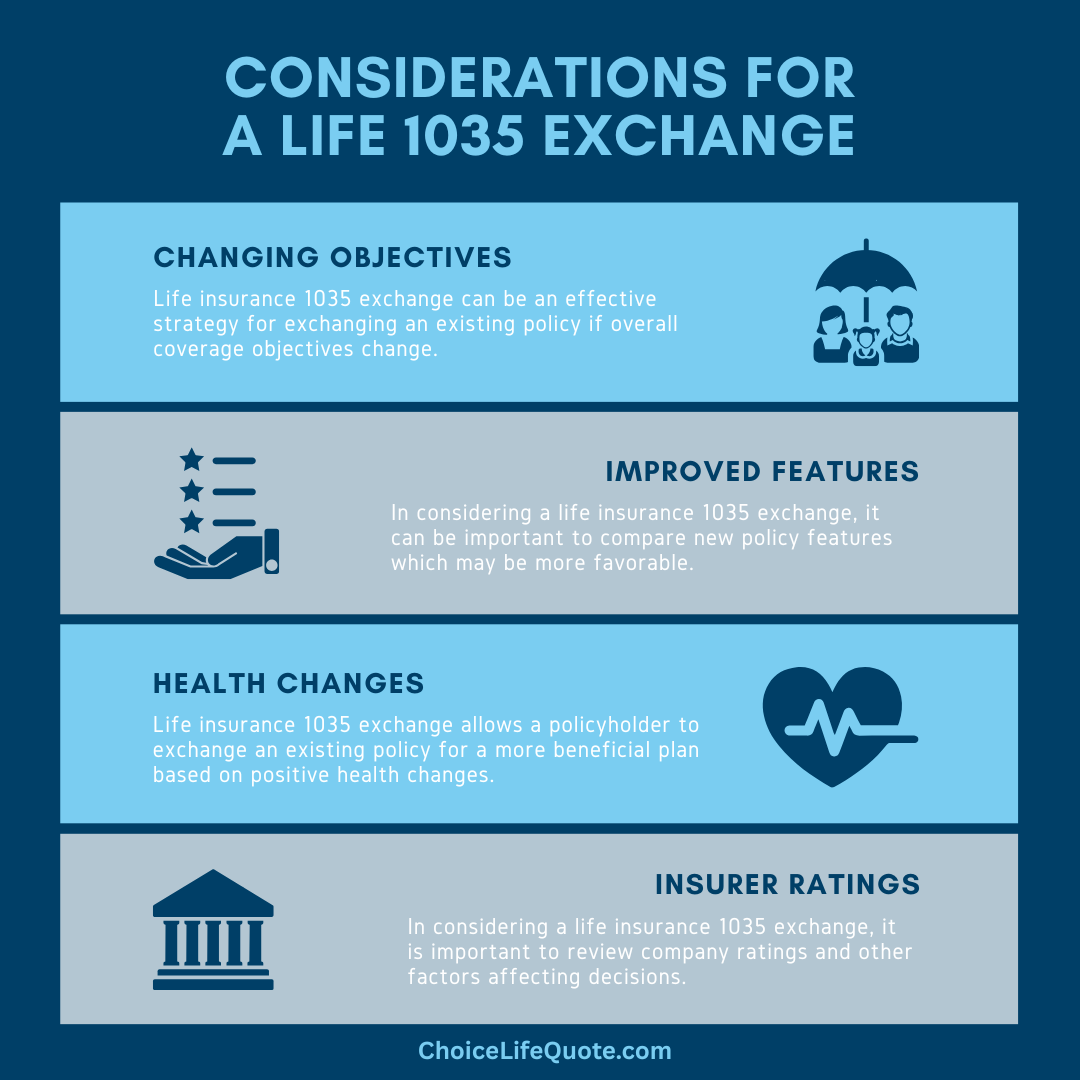Understanding Life Insurance 1035 Exchange

Are you considering exchanging one life insurance policy for another? If so, you may want to consider a 1035 exchange with life insurance. This strategy can allow you to transfer funds from one life insurance policy to another without triggering a taxable event.
This article discusses the intricacies of navigating the exchange of an existing life insurance policy utilizing the 1035 exchange to facilitate the optimization of both policy valuable benefits and critical tax advantages.
Understanding the 1035 Exchange
A 1035 exchange is a tax-free transfer of funds from one life insurance policy to another. This means that you can move the cash value of your existing policy to a new policy without incurring taxes on the gains.
The 1035 exchange is governed by section 1035 of the Internal Revenue Code, which allows for the transfer of funds between life insurance policies and annuities.

The primary reason for doing a 1035 exchange is to take advantage of better terms or coverage offered by a different insurance company. For example, you may have purchased a life insurance policy years ago and now realize that a different policy would better meet your needs. By doing a 1035 exchange, you can move the cash value from your old policy to a new one, without incurring taxes on the gains in cash value.
It’s important to note that the 1035 exchange has certain limitations on the types of policies that can be exchanged. For example, a life insurance policy can be exchanged for another life insurance policy, or a life insurance policy can be exchanged for an annuity contract, but an annuity contract cannot be exchanged for a life insurance policy.
Benefits of a Life 1035 Exchange
One of the main benefits of a 1035 exchange is that it allows you to switch to a different policy without losing the tax advantages you’ve already gained. When you surrender a life insurance policy, you may be subject to taxes on the gains in cash value. However, with a 1035 exchange, you can transfer the cash value of your existing policy to a new policy without incurring taxes.
Another benefit of a 1035 exchange is that it can allow you to take advantage of better terms or coverage offered by a different insurance company. For example, you may be able to get a lower premium or higher death benefit with a different policy. By doing a 1035 exchange, you can move the cash value from your old policy to a new one, without losing the tax advantages.
Finally, a 1035 exchange can be a great way to consolidate multiple policies into one. If you have several life insurance policies with different companies, you can do a 1035 exchange to consolidate them into one policy with a single company. This can make it easier to manage your policies and can potentially save you money on premiums.

Policies Eligible for 1035 Exchange
As mentioned earlier, not all life insurance policies are eligible for a 1035 exchange. The policies must be considered a like-kind exchange, meaning that they must be of the same type. Here are the types of life insurance policies that are eligible for a 1035 exchange:
Whole Life Insurance
Whole life insurance is a type of permanent life insurance that provides coverage for your entire life and provides significant policy guarantees. This type of policy has a death benefit, as well as a cash value component that accumulates over time.
Universal Life Insurance
Universal life insurance is another type of permanent life policy that provides coverage for your entire lifetime and offers significant flexibility. This type of policy also has a death benefit, as well as a cash value component that accumulates as premiums are paid and interest is credited.
Indexed Universal Life
Indexed universal life insurance is another type of permanent life insurance that provides lifetime coverage and offers a high level of flexibility. This type of permanent life policy also has a death benefit, as well as a cash value component that accumulates over time. The cash value interest crediting is linked to an index, such as the S&P 500, which can potentially provide a higher rate of return than traditional universal life policies.
Additionally, other permanent policies or variable policies, such as variable life, variable universal life, and other cash value plans may be available for exchange. It is recommended that policyowners discuss policy specifics with a licensed advisor to determine eligibility.
Completing a Life 1035 Exchange
Completing a 1035 exchange with life insurance can be a relatively simple process if you do a little research ahead of time. The general process has been provided below for review.
However, it is important to work with both insurance companies to ensure that specific requirements are met to successfully complete the transfer.

- Research and compare different life insurance policies to find the one that best meets your needs.
- Contact the insurance company that offers the policy you want to switch to and request a 1035 exchange.
- Provide the insurance company with the necessary information about your existing policy, including the policy number and the name of the insurance company.
- The insurance company will initiate the 1035 exchange by contacting your existing insurance company and requesting the transfer of funds.
- Once the transfer is complete, the cash value of your existing policy will be transferred to your new policy, tax-free.
It is important to note that you should not cancel your existing policy until the 1035 exchange is complete. If you cancel your policy before the exchange is complete, you may be subject to taxes on the gains.
Tax Implications of 1035 Exchange
One of the main benefits of a 1035 exchange is that it allows you to transfer the cash value of your existing policy to a new policy without incurring taxes on the gains. However, there are some tax implications that you should be aware of.
First, any gains that were deferred in your existing policy will be carried over to your new policy. This means that if you had gains in your existing policy, they would continue to be taxable when you withdraw them from your new policy.
Second, if you surrender your new policy within a certain period of time (usually within the first 15 years), you may be subject to surrender charges. These charges can reduce the cash value of your policy and can offset some of the tax benefits of the 1035 exchange.
1035 Exchange vs. Policy Surrender
When you decide to switch to a different permanent life insurance policy, you essentially have two options, completing a 1035 exchange or surrendering your existing life insurance policy and purchasing another policy. Considering the basic differences can help in making an informed decision. Key differences between the 1035 exchange and surrender have been provided below for review.
Taxes Implications
The main difference between a 1035 exchange and surrendering a policy are the tax considerations. With a 1035 exchange, you can transfer the cash value of your existing policy to a new policy without incurring taxes on the cash value gains. However, if you surrender your policy, you may be subject to taxes on these gains.
Cash Value
When you surrender your policy, you will receive the cash value of the policy, minus any surrender charges. With a 1035 exchange, the cash value of your existing policy is transferred to your new policy, which can help you maintain your existing cash value.
Death Benefit
When you surrender your policy, you will no longer have a death benefit. With a 1035 exchange, you can maintain your existing death benefit or potentially increase it with a new policy.
Conclusion
In conclusion, a 1035 exchange with life insurance can be a powerful strategy for getting the coverage you need while maximizing your tax benefits. By understanding the basics of this strategy, you can make an informed decision about whether it’s right for you. Whether you’re looking to switch to a different policy or consolidate multiple policies, a 1035 exchange can potentially help you achieve your financial goals.
Our team can assist in choosing the right type of policy, an appropriate amount of coverage, and the best insurance company for your situation. Get the quality coverage you need at affordable rates. Give us a call at (800) 770-8229 or request an instant quote today!
Disclaimer: Information is intended to be educational in nature and should not be considered financial, tax, or legal advice. Please consult a qualified professional for individual assistance.
The Staff Writers at ChoiceLifeQuote.com are insurance and financial services professionals with significant industry experience. The team’s experience and expertise help to provide consumers with a variety of educational content related to life insurance and annuities.


